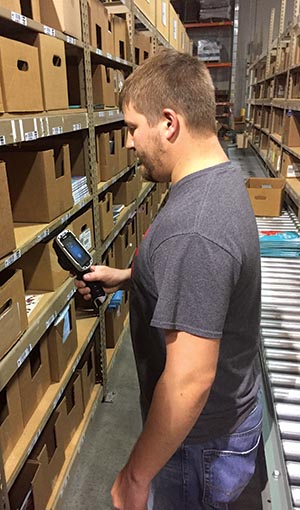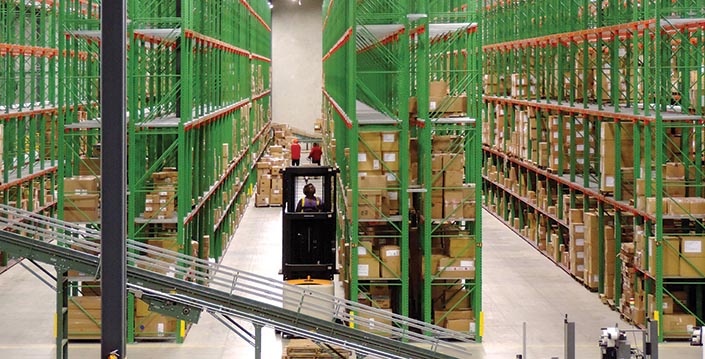Rethink Cycle Counting in your Operations
By taking a fresh look at their cycle counting practices, warehouse and DC teams are creatively using existing technology and resources to expand their cycle count benefits.
Cycle counting - counting small parts of an overall inventory on a relatively frequent basis—has evolved to replace traditional annual or quarterly physical inventories that required warehouse shutdowns and cut productivity. As companies assess and modify their cycle counting practices, they’re finding more ways to improve inventory accuracy, fill rate, productivity and profitability.
“Because there are so many options for cycle counting, it’s important to look at how it will best increase your inventory accuracy,” says Bryan Jensen, vice president and principal at St. Onge. Jensen categorizes cycle counting into two main types: active and passive. In active cycle counting, specialized staff run cycle counts in the most active warehouse locations.
“Cycle counting the most active products is where you’ll most likely find discrepancies,” Jensen says. Cycle counts can be performed in a basic location sequence, or more purposefully by counting 10% of locations within the warehouse that have had activity since the last cycle count, for example. “The advantage is that you can focus on fast-moving product, high-value product or high-concern SKUs such as upcoming sale items. Or, you can focus on product that has been picked by new employees and cycle count those locations to make sure employees are doing their jobs well,” he says.
Passive cycle counts often involve count-back techniques to confirm zero items in a location. They require less labor than active techniques and are typically used by lower volume distribution centers or in low-activity locations, Jensen says.
“Generally, the more activity you have at a lower unit level, whether pallets, cases or e-commerce operators that pick in pieces, you tend to do cycle counts more because it’s much more valuable. You have to decide: Is it best to touch your most active product or to cycle through in a flat fashion, going through the warehouse in waving cycles? Or is it best to use passive activities because you have so many pickers on the floor with active available touch points with your product already?”
In any case, the key is to ensure you count every part of your warehouse enough times during the year to maintain inventory accuracy and comply with audits and other requirements.
Evolving industry needs
 While cycle counting is used by all sectors and company sizes, practices vary by industry. Ken Mullen, senior managing partner at enVista, points out some industries that use cycle counting somewhat differently than traditional consumer products distributors or retailers.
While cycle counting is used by all sectors and company sizes, practices vary by industry. Ken Mullen, senior managing partner at enVista, points out some industries that use cycle counting somewhat differently than traditional consumer products distributors or retailers.
“Food and beverage products that have FDA requirements for freshness, dating, ripening or temperature control are cycle counted more frequently,” Mullen says. Their cycle counting functions must identify the category of item, validate temperature zones, and comply with associated regulations.
Pharmaceuticals also have FDA and e-pedigree requirements for accurate counts and tracking at any point in time—all of which drive different types of cycle counting. “If you’re audited or have a recall, cycle counting helps you have a discreet audit trail record and can locate product within your facility or wherever it’s been shipped,” Mullen says. “You don’t want to have to scramble to find that information during a recall or FDA audit.”
Combining technologies
The tools used these days to streamline and direct the cycle counting process are no strangers to the warehouse. They include RF, voice-directed picking, pick-to-light systems and others. Data- and rules-driven algorithms are then used to optimize which locations should be cycle counted and when.
“Most cycle counting makes use of technology that’s been justified by something else,” Jensen says. “Almost all warehouse management systems (WMS) have a cycle count capability of some sort in them.”
Dan Hanrahan, president of Numina Group, says his company incorporates WMS and voice-picking technology expertise into its real-time distribution software. “What we find in the voice pick area is that customers are looking for us to utilize voice for functions besides picking,” Hanrahan says. “If an operator is picking, we’re interleaving cycle counting into the process,” he says.
Hanrahan notes that in case picking, for example, a cycle count is often done on the last case. It generates replenishment as well as confirms counts and detects discrepancies. “When I start to pick the last case, I can force a discrepancy check and automate the cycle counting process,” he says. “This is also used in carton flow areas—interleaving a task with a voice pick to perform cycle counts automatically. If a discrepancy is detected, like an overpick, the operator can continue to pick, while a supervisor or other trained associate is notified to perform a more in-depth cycle count audit.”
Eric Lamphier, senior director of product management at Manhattan Associates, says his company’s systems also include voice prompts during replenishment or picking to confirm quantities. “We’re able to interleave that cycle counting confirmation right into the voice workflows, in addition to stand-alone voice cycle counting.”
What about new cycle counting technologies? Lamphier says his company has two new offerings. One is a new touch-only mobile picking app that drives associates through picking workflows from all types of locations and can also do cycle counting confirmation in low to zero inventory situations. Another is a new tablet solution that includes the ability for supervisors or managers to activate cycle counts on demand.
“You have to modernize the way you push out the screens and the work, and it has to be touch-centric, really intuitive and user friendly,” Lamphier says. “It has to drive high performance without a ton of training upfront.”

Best practices
Cycle counting has long been common practice in the warehouse and DC, with benefits including improved inventory accuracy, identifying errors in real time, increased productivity, faster throughput, higher fill rates and improved customer service. What’s not to like? As Jensen says, “Cycle counting gives you the power to direct your inventory control resources by area, product type or product velocity.”
But not all companies are using cycle counting to its full advantage—and they’re missing out on significant time efficiencies and cost savings, Mullen says. “They believe it can be hard to cycle count throughout the course of a day. A WMS can help drive the cycle counting process and keep track of what’s on hand or in transit, what’s come into a dock, or on an outbound dock. Many companies don’t take advantage of real-time inventory capability. But having a more realistic snapshot helps minimize cost disadvantages of poor inventory practices,” he says.
Here are six best practices to help you rethink cycle counting:
- Count opportunistically, when inventory levels are low, a location is empty, or during off-time, off-shift or evening. Lamphier says that within picking and replenishment algorithms, they’ve designed scenarios where an associate is systematically prompted to confirm a location is empty if they think it’s empty. “It’s a better way to get the job done,” Lamphier says. “You can also cap the number of location-SKU combinations to be counted. Maybe you only want a maximum of 100 cycle counting tasks done. The system looks at things like the date/time of last count as well as required categories such as date- or temperature-sensitive items, higher value items or fast-moving products where there’s more opportunity for error. It saves time and improves accuracy.”
- Interleaving is believing: Look for more opportunities to interleave cycle counting into other activities. If an associate is high up on a lift picking or replenishing, include functionality to cycle count additional locations there, Lamphier says. Use voice and/or RF to trigger a cycle count when the last item is picked at a location. Or when a forklift is empty at a receiving dock, do a cycle count there. “That’s a great time to cycle count—very easy, but it drives a high level of accuracy,” Mullen adds. “Understanding where you are in the warehouse drives interleaving activity.”
- Avoid starting cycle counts at the same location over and over. “We see a lot of companies start cycle counting at the same location, but only get so far then start again at that location,” Mullen says. Use your WMS to generate, for example, 100 locations that haven’t been counted in a recent given time period.
- Address any cycle count discrepancies—stat! Any time there’s an exception recorded for a location, such as a skip, shortage or partial shortage during inventory placement, picking or removal, systems should trigger a cycle count activity, often times by another associate to perform a cycle count activity on that location. The picker shouldn’t stop the picking activity to do in-depth investigation.
- Involve your auditing partner in your cycle-counting strategy. Beyond the alerting, tasking and reports, reviewable and accurate logs are as important on the financial auditing side as anything, Lamphier says. “A lot of our customers have gotten to a point with their auditors that their SOPs and system options have been approved because they drive great results and higher inventory integrity.”
- Understand the value of cycle counting. Go for the gold. Raise the bar on your inventory accuracy goals. Lamphier, Hanrahan and Mullen all note they’ve seen inventory accuracy rise from 75% or 80% to more than 99% when cycle counting is well implemented. Mullen asks, “When you quantify the difference between 80% and 99% accuracy, and the value of inventory on top of that, why would you want to be 15% or 20% inaccurate, especially for a highly valuable or time-sensitive inventory?”
Mullen also noted examples of cycle counting success:
- A large pharmaceutical retailer had a controlled substance inventory and used cycle counting not only at the warehouse, but also on the delivery truck and at the retail store. Inventory accuracy increased more than 15% from previous levels.
- A food and beverage distributor that implemented accurate cycle counting at the time of receiving an item into the warehouse all the way through to shipment saved itself six figures.
- Cycle counts also reduced theft of high-dollar value items by 9% to 10% at a warehouse facility in the amusement theme park industry.
Ultimately, you can reduce the need for cycle counting by ensuring that your pick, pack and ship process is verified with a combination of technologies and processes, Hanrahan says. “Looking at fulfillment as a holistic process, with cycle counting as a feature, builds accuracy in the outbound process.”
Companies mentioned in this article
• enVista
• Manhattan Associates
• Numina Group
• St. Onge.













